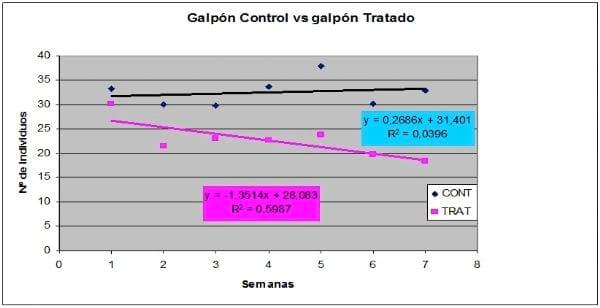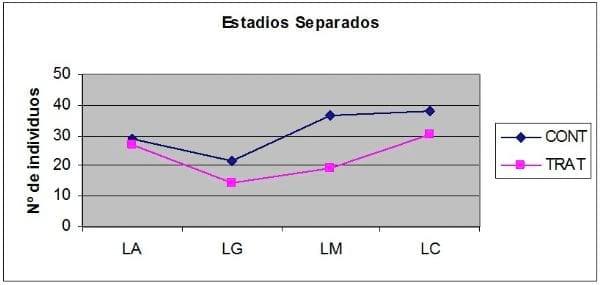Introduction
Alphitobius diaperinus (Panzer), popularly known as "cascarudo" [thick-shelled beetle] (Rohde et al., 2006), belongs to the phylum Arthropoda, class Insecta, order Coleoptera and Family Tenebrionidae (Paiva, 2000). It is a pest of stored grain that has adapted to poultry houses (Vaughan et al., 1984; Arends, 1987; Mac Allister et al., 1995). It affects poultry facilities by producing physical damages, and to birds through the transmission of several diseases, such as Salmonellatyphimurium (Rezende, et al. 2009), Escherichia coli, Gumboro and Newcastle (Eidson et al., 1966; De Las Casas et al., 1973). Birds eat the beetles so there is a reduced feed consumption, body weight loss and decreased production (Matías, 1995).
Materials & Methods
The trial was conducted in two poultry houses of a farm with a high degree of contamination with Alphitobius diaperinus in litter. Litter consisted of rice hulls, used in a previous growing period.
In one of the houses, litter was treated with the product Eco-Guard® (200 g/m2), while the other, without the product, was considered as control treatment.
Sampling was done weekly by taking litter temperature data and litter samples for lab analysis of dry matter, expressed as moisture and Alphitobius diaperinus count expressed as the number of insects per 100 g of litter.
The sampling was done by taking litter samples of the two poultry houses, in certain areas such as left side and right side. Each side in turn was sampled in the side, under the waterers and under the feeders. The material obtained at each point (total of 15 sampling points) was placed in a container and it was homogenized at the end of the house. From this, a subsample was taken (2-3 kg) in a polyethylene bag for subsequent Alphitobius count at the lab. At the end of each stage, two samples per house were taken. For the sample extraction a metal cylinder was used, placed vertically as a trier. To count Alphitobius, a separation, classification and counting of the insects was performed. Adults were directly counted. Larvae were classified as: greater than 1 cm in length, between 0.5 and 1 cm in length and less than 0.5 cm in length, corresponding to two stages of insect development (adults and larvae). (Cecco et al., 2005).
Temperature and moisture data, as well as quantity of Alphitobius diaperinus were analyzed using an analysis of variance. For total number of individuals, a regression over time was carried out, comparing slopes between the two treatments.
Results & Discussion
Litter moisture and temperature
No statistically significant differences in litter moisture between control and treated houses (Table 1) were observed. It should be noted that this was the result of the average of the different sampling points of litter temperatures through the six-week study, which showed a high variability in individual data.
Table 1. Litter moisture content in %.
Means with the same letter are not significantly different.
Also, no differences were observed in litter temperatures values (Table 2), during the different weeks, except for the fourth week where Control had a higher temperature than Treated. Just as with moisture, temperature data showed a high variability in the different sampling points.
Table 2. Average temperatures taken at the house litter (in °C)
Means with the same letter within a column are not significantly different (P>0.05).
Alphitobius diaperinus Count
Figure 1 shows the regressions of the Treated and Control groups. The slopes are significantly different (P=0.06). This shows that the product is effective in reducing the number of Alphitobius diaperinus. Alves et al., 2006 found the same behavior with a product of similar characteristics. However, it is considered that samples taken from each point of the house should have not been mixed, but each should have been considered individually. This would have increased the amount of data per sampling, lowered the high variability and even would have allowed us to compare the product performance on Alphitobius diaperinus in places with different characteristics, such as under the feeders and waterers, and in the side of the house.
Figure 1. Total number of Alphitobius diaperinus (number of individuals per 100 g of litter) in Control vs Treated houses.
Figure 2. Comparison of the amount of Alphitobius diaperinus at different stages of development, separately (number of individuals per 100 g of litter)
Table 3. Number of individuals per 100 g of litter.
SE = standard error; LA = Adult, LG = large larvae, more than 1 cm; LM = medium larva , between 0.5 and 1 cm; LC = larva less than 0.5 cm.
The effect of product on the different stages of insect development can observed in Figure 2 and Table 3. The number of larvae between 0.5 and 1 cm in length was statistically different between treatment and control (P <0.06).
Conclusions
The product Eco-Guard® produced a significant decrease (P=0.06) on the number of individuals throughout the evaluation period
The high coefficient of variation in some of the measured parameters indicates that it would be necessary to increase the number of replicates per poultry house to improve the sensitivity of the methodology used. Due to the high variability of data, it is suggested to modify the sampling plan. The number of samples should increase and counting of Alphitobiusdiaperinus should be made considering the individual sampling sites (under feeders, under waterers and sides of the house), because there are differences in environmental conditions (moisture due to waterers leaks, feed waste in troughs and different temperatures according to the location of the brooders).
References
Alves LFA, Buzarrello GD, Oliveira DGP, Alves SB. 2006. Acao da terra de diatomeácea contra adultos do cascudinho Alphitobius diaperinus (Panzer, 1797) (coleoptera:Tenebrionidae). Arq. Inst. Biol. 73(1):115-118.
Arends JJ. 1987. Control Management of the litter beetle. Poultry Digest. :172-176.
Cecco l, González H, Deluchi P, Barrios H, De Franceschi M. 2005. Determinación de los estados de desarrollo de Alphitobius diaperinus en granjas avícolas. Rev. Arg. Prod. Animal 25:93-99.
De Las Casas E, Harein PKD, Eshmuck DR, Pomeroy BS. 1973. The relationship between the lesser mealworm and avian viruses. I. Reovirus 24. Environ. Entomol. 2:1043-1047.
Eidson CS, Schmittles SC, Goode RB, Lal JB.1966. Introduction of leucosis tumors with the beetle Alphitobius diaperinus. American Journal Veterinary Research 27:1053-1057.
Matias RS.1995. Cascudinho; portador de vários patógenos, e Cascudinho têm apresentadoum serio problemaas aves. SaoPaulo. Zeneca. Saúde Publica 2p (Cicular Técnica).
McAllister JC, Steelman CD, Newberry LA, Skeeles JK. 1995. Isolation of infectious bursal disease virus from the lesser mealworm, Alphitobius diaperinus (Panzer). Poultry Sci. 74:45-49.
Paiva DP. 2000. Controle de moscas e cascudinhos. Desafios na Produção Agrícola. pp 21-26. In: I Simpósio sobre resíduos da produção avícola. Embrapa Suínos e Aves (Concórdia, Brasil).
Rezende SRF, Curvello FA, Fraga ME, Reis RCS, Castillo AMC, Agostino TSP. 2009. Control of the Alphitobius diaperinus (Panzer) (Coleoptera: Tenebrionidae) with entomopathogenic fungi. Rev. Bras. Cienc. Avic. 11(2)
Rohde C, Alves LFA, Neves PMOJ, Alves SB, Da Silva ERL, De Almeida JEM. 2006. Seleção de Isolados de Beauveria bassiana(Bals.) Vuill. E Metarhizium anisopliae (Metsch.) Sorok. Contra o Cascudinho Alphitobius diaperinus (Panzer) (Coleóptera: Tenebrionidae). Neotropical Entomology 35:231-240.
Vaughan JA, Turner Junior EC, Ruszler Pl. 1984. Infestation and damage of poultry house insulation by the lesser mealworm, Alphitobius diaperinus, (Panzer). Poultry Sci. 63:1094-1100.









.jpg&w=3840&q=75)